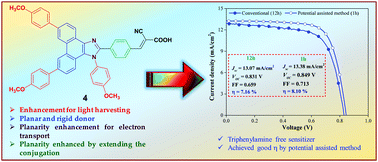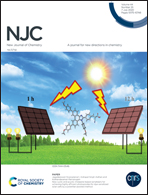New cyclic and acyclic imidazole-based sensitizers for achieving highly efficient photoanodes for dye-sensitized solar cells by a potential-assisted method†
Abstract
A series of systematically tailored aryl acyclic (biphenyl, dye 1 and 2), cyclic (phenanthrene, dye 3 and 4) and methyl-substituted (dye 5) imidazole derivatives were synthesized and characterized for application in dye-sensitized solar cells (DSSCs). The anisole ancillary donor was attached to the –NH position in the imidazole center to obtain dyes 2 and 4. Cyclic voltammetry and UV-visible studies of all the dyes indicate their suitability for DSSC applications. Among the as-synthesized dyes, dye 4 with a phenanthrene donor and anisole ancillary donor showed the highest power conversion efficiency (PCE) of 7.16% (JSC = 13.07 mA cm−2, VOC = 0.831 V, FF = 0.659). Dye 2 displayed the highest electron lifetime in the conduction band of the photoanode; hence, the open circuit voltage of the DSSC based on dye 2 was the highest among the studied dyes (0.865 V). By using a novel potential-assisted dye staining process, the dye loading on the photoanode was enhanced by 18% in 1 h, which in turn enhanced the PCE to 8.10%.



 Please wait while we load your content...
Please wait while we load your content...